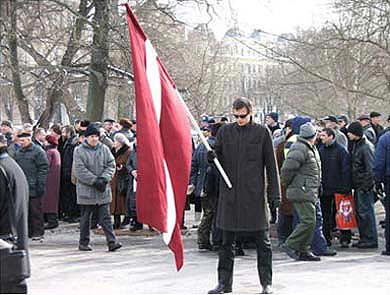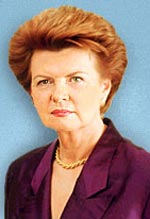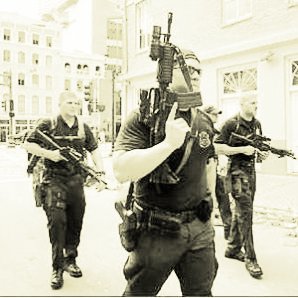On March 16, 2005, a Waffen SS demonstration took place in the capital of a state that recently became a member of the European Union and NATO: Latvia. Authorities decided to allow it and to repress the citizens who protested. Far from being an isolated action, this event represents the culmination of a process, which aims at denying the disappearance of Nazism and rehabilitating it, led by the president of the Republic, Vaira Vike-Freiberga and openly financed by the Embassy of the United States. It takes place after Nazi parties have assumed power in different “democratized” states like, for instance, Ukraine.

The events of March 16, 2005, in Riga (Latvia) have inflamed the feelings in Eastern Europe and Russia but it is very unlikely that the Atlantist press (that of western Europe and the European community) will make any reference to them. Actually, the facts speak for themselves and reflect an inadmissible aspect of NATO and the European Union since its expansion on May 1, 2004.
On the initiative of the Nazi association Club 415, and for the fifth consecutive year although for the first time in the heart of NATO and the European Union, several hundreds of Waffen SS marched in the center of the capital. The demonstration, which was authorized by the municipal council of Riga, was protected by security forces, while people who were peacefully protesting against it were brutally repressed and some of them submitted to interrogation.
This case is not about a traditional clash between right-wing skinheads and the extreme left but a political act that emerges from a deep reflection, personally organized by the president of the Republic and that marks the culmination of a quick process of Nazi rehabilitation. It is not a repugnant provocation with a domestic effect either but an international strategy, organized by NATO, which deliberately gives guarantees to clandestine organizations that have to be acknowledged for their contribution to the de-Sovietization of Europe and which are already linked to several governments, especially in the «orange» Ukraine.
In order to understand what is at stake in this game, it is necessary to go back in time.
During World War II, the Nazis created 37 divisions of Waffen Schutzstaffel (Waffen SS) of which only 12 were comprised exclusively by Germans [1] . Most of the members of the divisions were recruited among the so-called «Aryan» populations of the occupied or annexed countries. Although the Latvians were not all considered «Aryan», they were massively recruited. Out of 900,000 Waffen SS, almost 150,000 were Latvians thus being the largest foreign contingent while their country, Latvia, only had two million inhabitants. The Latvians were mainly placed in the 15th Infantry Division, which was the most decorated non-German Waffen SS unit. It was them who entrenched themselves in Berlin and engaged in the last military actions of the Third Reich.
The Latvian SS did not fight to defend their country but mainly against the Resistance in Russia and Belarus. Most of them were volunteers, although, in 1944, they were joined by some recruits who had been forced to enlist.
On the other hand, other Latvians - nearly 130,000 - enlisted to fight against the Axis (Hitler’s Germany, Mussolini’s Italy and Japan). Most of them fought in the Red Army that liberated their country from Nazism. After the negotiations among the Allies, Latvia, like other Baltic states, was absorbed by the Soviet Union.
Even before the end of World War II, the British secret services recruited agents among the Nazi war criminals (specially members of the Arajs Kommando) to fight Communism and infiltrated them in Sweden with the help of the SMT, the local secret service. Thus, an SS unit was formed by 1,500 men under the command of Colonel Osis, aiming at launching an attack against the Soviets. However, this idea was abandoned after the Nuremberg Trial labeled the Waffen SS and all its sections as «criminal organizations». In 1949, these agents were transferred to Hamburg (to the German zone occupied by the British) where they would be trained by the MI6 - British Secret Intelligence Service - («Jungle Operation»). The «best» elements received an additional training in Great Britain. They soon became part of what would become NATO’s «stay-behind» network, jointly directed by Great Britain and the United States [2]. Several parachuting and infiltration operations in espionage and sabotage missions took place but they all failed, causing a cruel repression by the Soviets. Eventually, this method was abandoned in 1952 when it was replaced by psychological operations [3] .
Those networks remained active during the entire Cold War period. In 1997, Germany revealed that it was still giving pensions to 50,000 former SS or their rightful successors, spread around the world. Thus, Reinhard Heydrich’s widow (he was the architect of the «final solution») or Heinz Barth (responsible for the massacre of Oradur-sur-Glane) continue to receive salaries from the German government in spite of their crimes [4] .
From the Anglo-Saxon point of view, this investment was not useless as it provided a framework to assume power after the collapse of the Soviet Union. And that process is far from over. Thus, when during the recent orange «revolution» [5] , agents of these networks - regrouped in the heart of the Congress of the Ukrainian Nationalists (KUN) and the Pan-Ukrainian Party of Liberty (Svoboda, former SNPU) - joined «Our Ukraine» - the so-called democratic coalition of Viktor Yuschenko and gave it the necessary political structure - there was absolutely no doubt about the Nazi identity of these groups. The first one explicitly includes in all its documents the phrase: «Facción Stefan Bandera» («Faction, Stefan, Flag») while the second one uses the trident and the swastika as symbols. Not to mention the friends of Mrs. Timoschenko (Ukraine’s Foreign Minister): the UNA-UNSO, a paramilitary organization created after the 1991 putsch in Moscow that is comprised of more than 1,000 combatants, men who went to fight in Croatia with the CIA and later together with the insurgents in Chechnya and Georgia.
Of these groups, only the Svoboda (Freedom) has been kept inactive after its leader, Oleh Tyhnybok praised those who, during World War II, had «cleared the country of Jews and Russians» and urged everyone to follow their example returning «Ukraine to the Ukrainians» and «setting the country free from the Muscovite Jews that exploit it» [6] . They were very careful not to show swastikas during the orange «revolution» that was televised when most of the paid demonstrators had been recruited in these Nazi organizations.
Anyway, the KUN and the UNA-NAS have been considered appropriate, or «clean», interlocutors, known for such a long time that the general secretary of the European Union and NATO, Spain’s Javier Solana, accepted to talk to them.
What is happening today - it be in Europe or anywhere else like Lebanon, for instance, where the Falangists are presented as defenders of democracy - has nothing to do with the expansion of freedom of which President George W. Bush boasts, but with the continuation of the worst of policies that began with the Cold War and no longer has any obstacles.
In this perspective, the MI6 and the CIA took control in Latvia where, due to the post-Soviet chaos, they put their men ahead the state. In the country, the disillusioned population speaks of the «gang of foreigners», reported journalist Rumania Ougartchinska in her last work [7] . An example of that is the Office for the Protection of the Constitution (SAB) [8], in charge - above all - of defending democracy, which is headed by Janis Kazocinu, who is actually a general of the British who was appointed military attaché in Riga during the independence and then deputy of the Chief of Staff. He only acquired the Latvian citizenship when he was granted the appointment.

Professor Vaira Vike-Freiberga plays an essential role in this mechanism. The family of this Canadian, who fled Latvia when the Third Reich of Adolf Hitler fell, was linked to the Nazi agents of NATO’s stay-behind networks through a clandestine association destined to the Diaspora: the Hawks of Daugava River (Daugavas Vanagi). Meanwhile, the family of her husband, Imants Freibergs, was linked to the MI6 in Germany at the end of World War II. Vike-Freiberga, Psychology professor at the University of Toronto, specialist in the influence of drugs on human behavior, settled in Riga in early 1999 and acquired the Latvian citizenship. Then, in the spring, she was elected President of the Republic, winning a second term four years later.
During the last years, President Vike-Freiberga has devoted herself to re-writing European history. In her opinion, Latvia was successively occupied by the Soviets, the Germans and again by the Soviets. Also according to her, the Latvians who joined the SS did it only to find an ally to liberate their country. In short, their crimes were comparable. For that, she based her reasoning in a peculiar interpretation of the Ribbentrop-Molotov Pact, which would have been the result of the totalitarian nature of the Nazi and Communist regimes. Today’s Germany could not be held responsible for the Nazi crimes but today’s Russia would always be responsible for crimes of Stalinism.
However, this interpretation does not reflect reality: the Ribbentrop-Molotov Pact is, above all, an extension of the Munich Accords (Germany, France, Italy, and United Kingdom) to determine the areas of influence in the East after the distribution of Czechoslovakia among Germany, Poland and Hungary. In addition, it is necessary to integrate the role of Latvia itself during that period. Finally, we are astonished by the fact that she ignored the role of the Red Army in the liberation of Europe from the dun plague (the Fascists wore dun and black shirts), and described as traitors those Latvians who joined the Red Army. Anyway, the new Riga credo consists in presenting the Soviets as devils and to rehabilitate the Nazis who fought them.
In January 2005, the Latvian government published a work entitled History of Latvia: 20th Century; the book openly says that it was printed with the financial assistance of the US Embassy and its launching took place during a press conference of the president of the Republic. Among other things, we are surprised to read in the book that the camp of Salaspils, where the Nazis carried out medical experiments with children and 90,000 people were killed, was simply a «corrective working camp» and that the Waffen SS were heroes of the struggle against the Soviet occupying forces.

This book, as well as other school handbooks, cause rage among the Russian Parliament members and government and also in many countries of Eastern and Central Europe.
That is why Israel and Russia officially asked Latvia not to authorize the meeting of the Waffen SS on March 16. However, their petition was rejected.
Finally, let us underline that Latvia simultaneously joined NATO and the European Union during its expansion in May 2004, and much of that happen due to Washington’s dictates. For fifty years, the European Union has been the result of the combined willingness of the United States to anchor the western part to the Atlantist bloc to stop the Russian influence and the Europeans’ efforts to unite instead of destroying themselves. Today, the western Europeans no longer have to be protected from the «red danger» and Nazism is rehabilitated. The Union no longer represents peace.
From that moment on, it is easy to understand that in the middle of the referendum about the European Constitutional Treaty, the Atlantist media does not want to acknowledge the facts although, in spite of everything, there was a news wire of the France Press (AFP) news agency which presented the demonstration as a commemoration of «the former Latvian combatants that were forced to enlist in the German ranks of the Waffen SS during World War II»; it was a «homage to those legionary soldiers». The AFP did not describe as democrats those who opposed the demonstrators but as «pro-Russian radicals» [9] .
[1] Data from 1944
[2] «Stay-behind : les réseaux d’ingérence américains», by Thierry Meyssan, Voltaire, August 20, 2001
[3] See: MI6, Inside the Covert World of Her Majesty’s Secret Intelligence Service, by Stephen Dorril, Chapter 16, The Free Press, 2000
[4] « War criminals get pensions », Associated Press, February 7, 1997
[5] «Ukraine : la rue contre le peuple», Voltaire, November 29, 2004
[6] « Ukraine : Ultra-right groups support Yushchenko », by Justus Leicht, The Guardian, December 15, 2004
[7] KGB et Cie, à l’assaut de l’Europe by Roumania Ougartchinska, Anne Carrère Publishing House, 2005
[8] Satversmes Aizsardzibas Biroja
[9] « 20 arrestations lors de la marche en mémoire des Letttons enrôlés dans les SS », AFP, March 16, 2005, 14h08

 Articles by this author
Articles by this author Send a message
Send a message





















Stay In Touch
Follow us on social networks
Subscribe to weekly newsletter